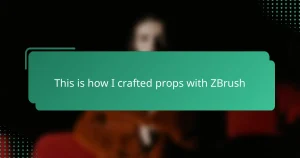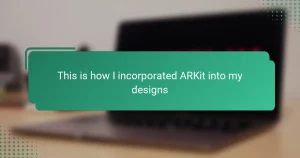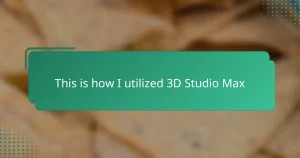Key takeaways
- Real-time rendering allows for instant feedback, enhancing creativity and enabling rapid experimentation in design, particularly for sci-fi props.
- Balancing performance with visual quality is a key challenge, requiring careful management of lighting, texture, and model complexity.
- Effective lighting and texture optimization significantly improve the realism of digital props, transforming them into believable storytelling tools.
- Real-time rendering is not just a technical process; it fosters a dynamic dialogue between imagination and technology in the design journey.
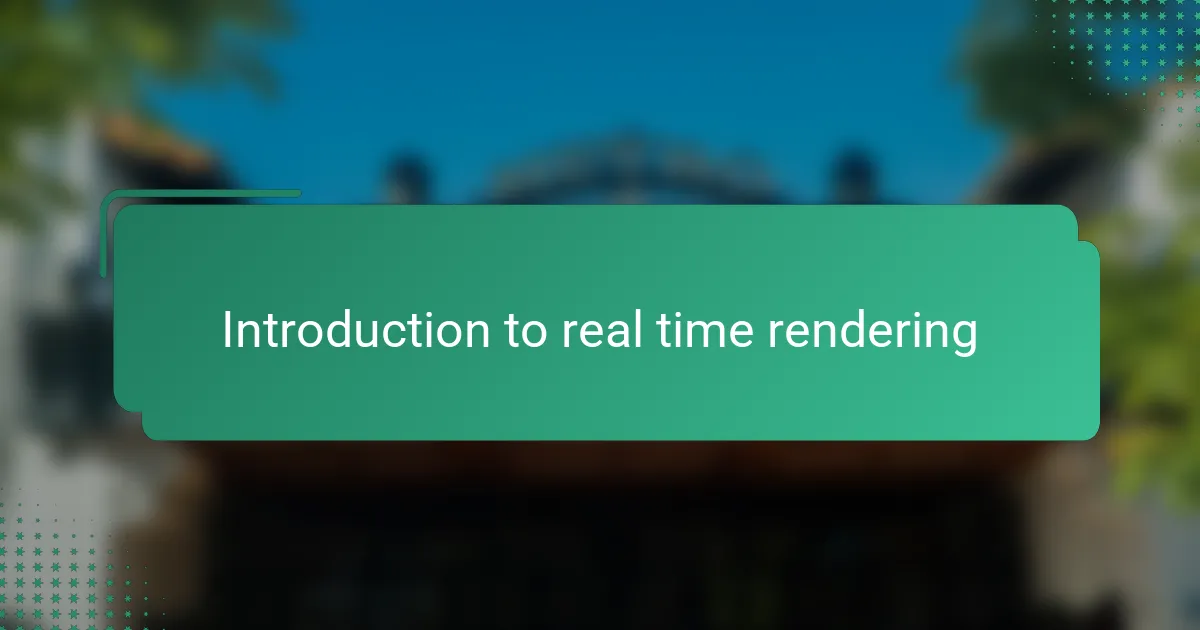
Introduction to real time rendering
Real-time rendering is a fascinating process where images are generated almost instantly as you interact with them. When I first encountered this technique, I was amazed at how quickly complex scenes could come to life without noticeable delay—something that truly transformed my work with science fiction props. Have you ever wondered how your favorite video games or movies manage to create such immersive, dynamic visuals on the fly?
In my experience, real-time rendering combines both speed and visual fidelity, which can be a tricky balance to achieve. It requires powerful hardware and smart algorithms that calculate lighting, shading, and textures in just milliseconds. This immediacy has a magical effect, making virtual worlds feel tangible and responsive, which is exactly what grabbed my attention in the realm of sci-fi prop design.
What excites me most about real-time rendering is its potential for creativity. Being able to see adjustments instantly means I can experiment endlessly, tweaking details and immediately observing the results. This fluid creative loop is something I hadn’t experienced before, and it changed how I approach visual storytelling with futuristic props.
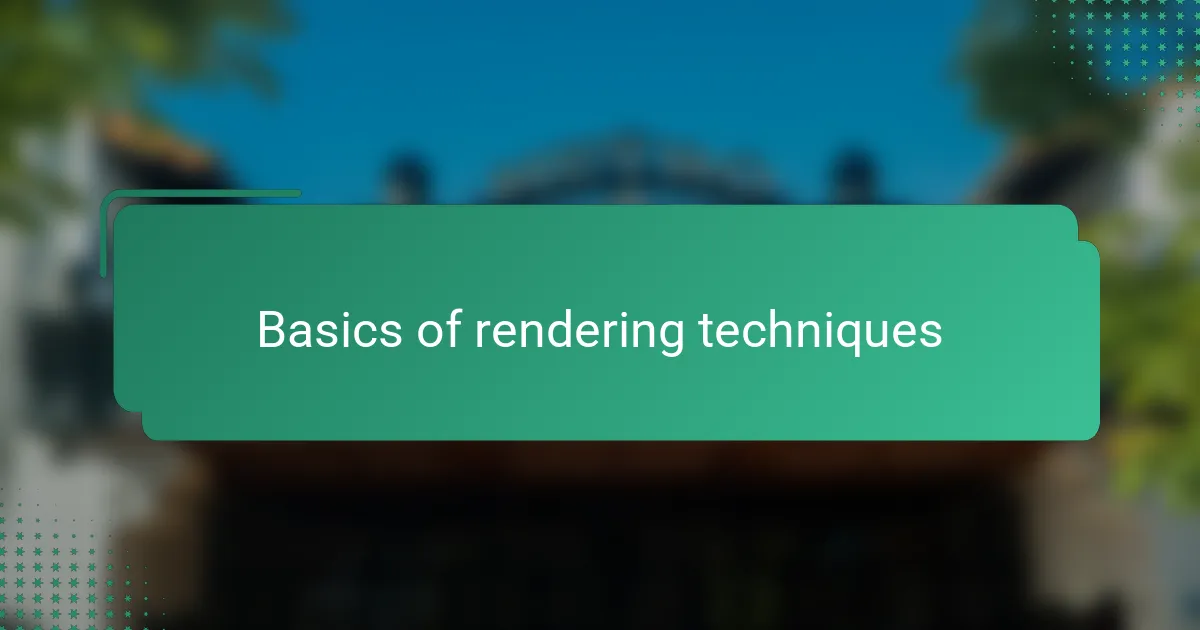
Basics of rendering techniques
Rendering, at its core, is about turning digital data into the images we see on screen. When I first learned about rasterization—the backbone of many real-time rendering techniques—I was struck by how it simplifies complex 3D models into manageable 2D images, pixel by pixel. It felt like watching a magic trick unfold, where static shapes suddenly become vibrant scenes.
What really fascinated me is how lighting gets calculated in these processes. Techniques like shading simulate how light interacts with surfaces, adding depth and realism. I remember tweaking lighting parameters on a sci-fi helmet prop and being amazed at how subtle changes could completely transform its appearance, even in real time.
Then there’s texture mapping, which wraps detailed images onto 3D models to give them character and authenticity. This step made me realize how important small details are—like scratches or metallic gleams—that bring props from bland to believable. Have you noticed how the tiniest texture tweak can breathe life into a digital object? That discovery certainly changed how I think about rendering’s role in storytelling.
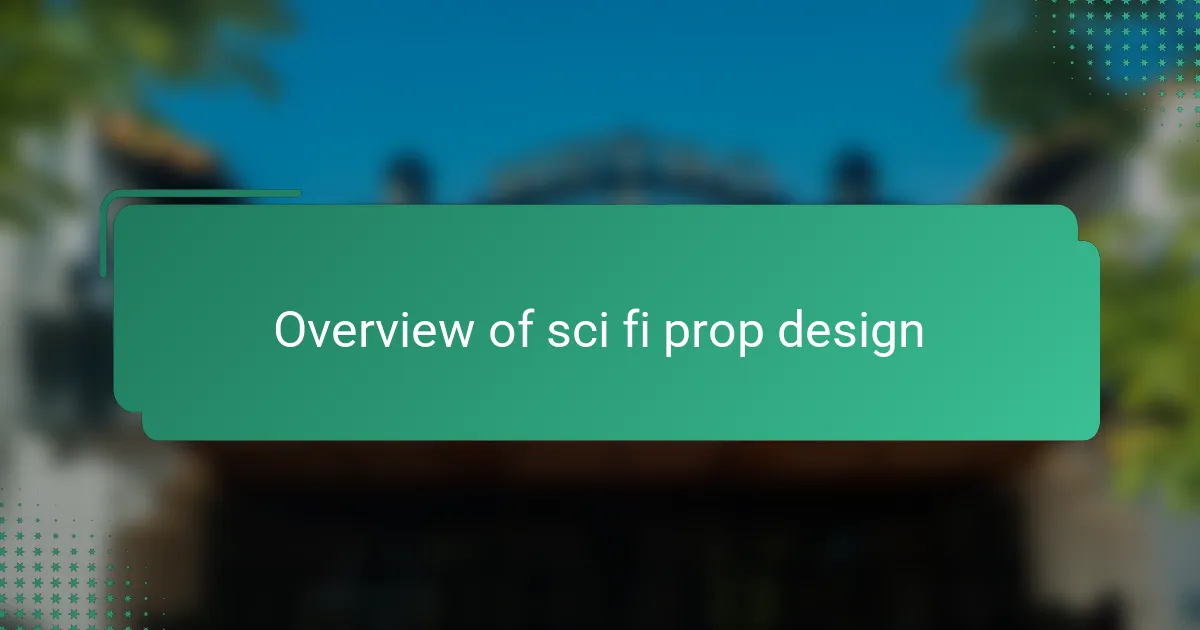
Overview of sci fi prop design
Designing sci-fi props always feels like stepping into another world. I’ve found that the key lies in blending imagination with functionality—each element must tell a story while still looking plausible. Have you ever held a prop and felt it wasn’t just a cool object, but a piece of a universe? That’s exactly what I strive to create.
What intrigues me most is how sci-fi prop design often balances futuristic aesthetics with practical materials. When working on a digital model, I constantly ask myself: could this exist beyond the screen? This mindset pushes me to refine details, from sleek surfaces to intricate mechanical parts, making every piece feel authentic.
I recall a project where I experimented with unconventional shapes and textures to capture an alien tech vibe. The challenge wasn’t just in designing something unique but ensuring it fit within the story’s world. That experience deepened my appreciation for how thoughtful design turns props into powerful storytelling tools.
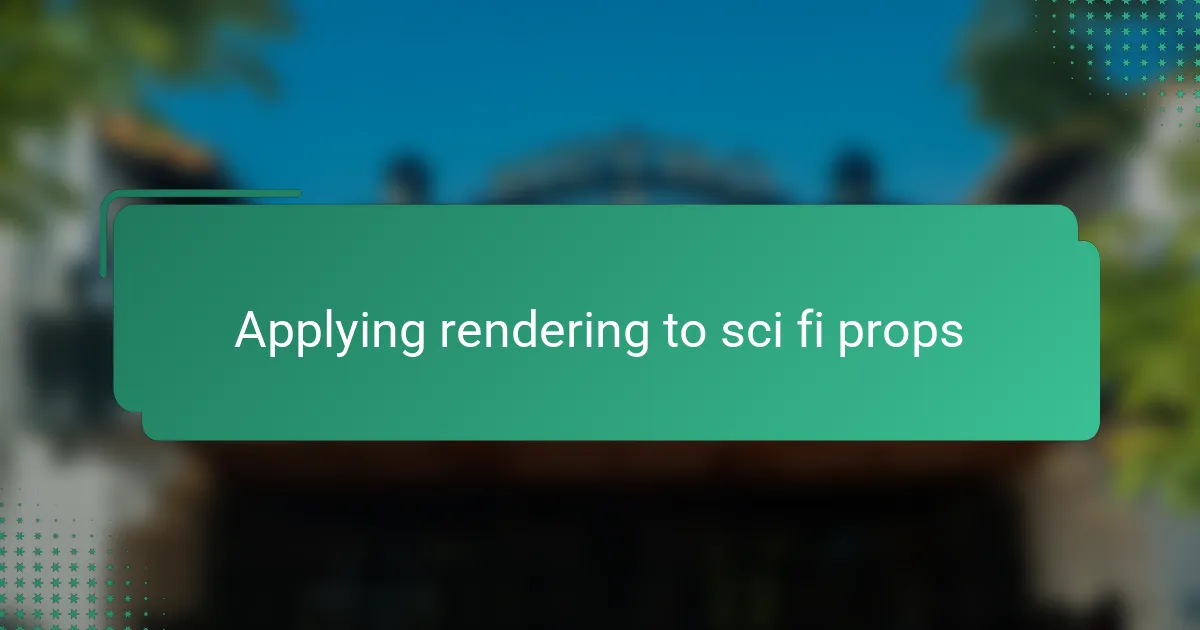
Applying rendering to sci fi props
Applying rendering to sci-fi props truly opened a new dimension in my creative process. When I saw how real-time rendering could instantly show reflections on a metallic surface or subtle glows from futuristic screens, I felt like the prop was coming alive before my eyes. Isn’t it incredible how rendering brings these imagined objects closer to reality?
I remember working on a digital blaster model where adjusting the shader in real time allowed me to simulate wear and tear instantly. Seeing the scratches and light bouncing off the edges change dynamically gave me a much deeper connection to the piece. It felt less like making a model and more like crafting a story that unfolds with every visual tweak.
What surprised me most was how rendering techniques guided my design decisions. Sometimes, a cool idea looked amazing on paper but didn’t translate well once rendered, so I had to rethink textures or shapes. That challenge pushed me to fine-tune every detail, and in doing so, I learned that rendering isn’t just a tool—it’s a collaborator in building believable sci-fi worlds.
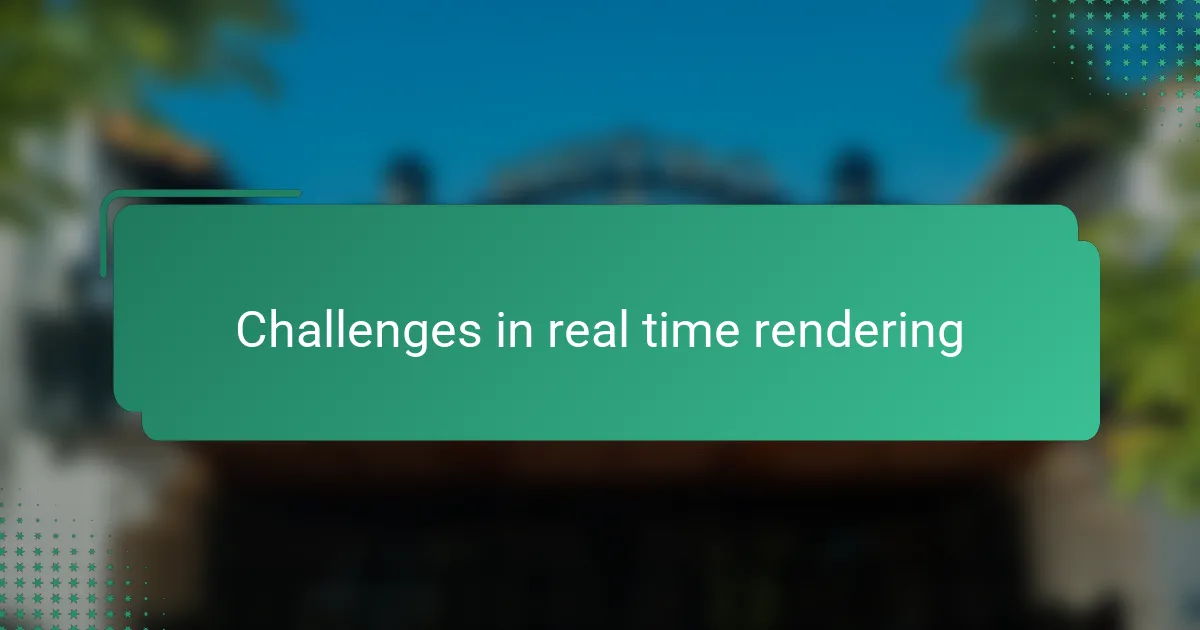
Challenges in real time rendering
One of the biggest challenges I’ve faced with real-time rendering is managing performance without sacrificing visual quality. Have you ever noticed how a beautifully detailed sci-fi scene suddenly lags or stutters? Balancing intricate models and effects while keeping the frame rate smooth can feel like walking a tightrope.
Another hurdle that intrigued me is lighting complexity. Real-time calculations for shadows and reflections can be brutally demanding on hardware. I recall spending hours tweaking a lighting setup for a futuristic helmet prop, only to realize that making it look perfect meant pushing my system to its limits—and sometimes beyond.
Then there’s the struggle with texture optimization. I learned the hard way that throwing ultra-high-resolution textures everywhere isn’t a solution; it slows everything down. Finding that sweet spot where textures look sharp but load quickly was like solving a puzzle that kept evolving with each new prop I designed. Have you ever wrestled with this trade-off? It’s a constant learning curve, but it makes the final result all the more satisfying.

Personal insights and experiences
Working closely with real-time rendering has been an eye-opening experience for me. I recall the first time I saw a fully rendered sci-fi prop shift instantly in response to lighting changes—it felt like holding a living object in my hands, not just a digital model. That moment really solidified my appreciation for how immediate feedback fuels creative passion.
Sometimes, the most challenging projects turned into my greatest learning opportunities. For instance, when tweaking a complex alien gun model, real-time glitches forced me to rethink my approach and optimize smarter, not harder. Have you ever had to pivot your creative process because technology pushed back? Those situations taught me resilience and the importance of patience.
What I value most is how real-time rendering transforms tedious waits into dynamic exploration. Being able to iterate designs on the fly means I stay deeply connected to the creative flow—something that’s hard to replicate with slower workflows. It’s honestly changed how I see prop design: as an evolving conversation between imagination and technology.
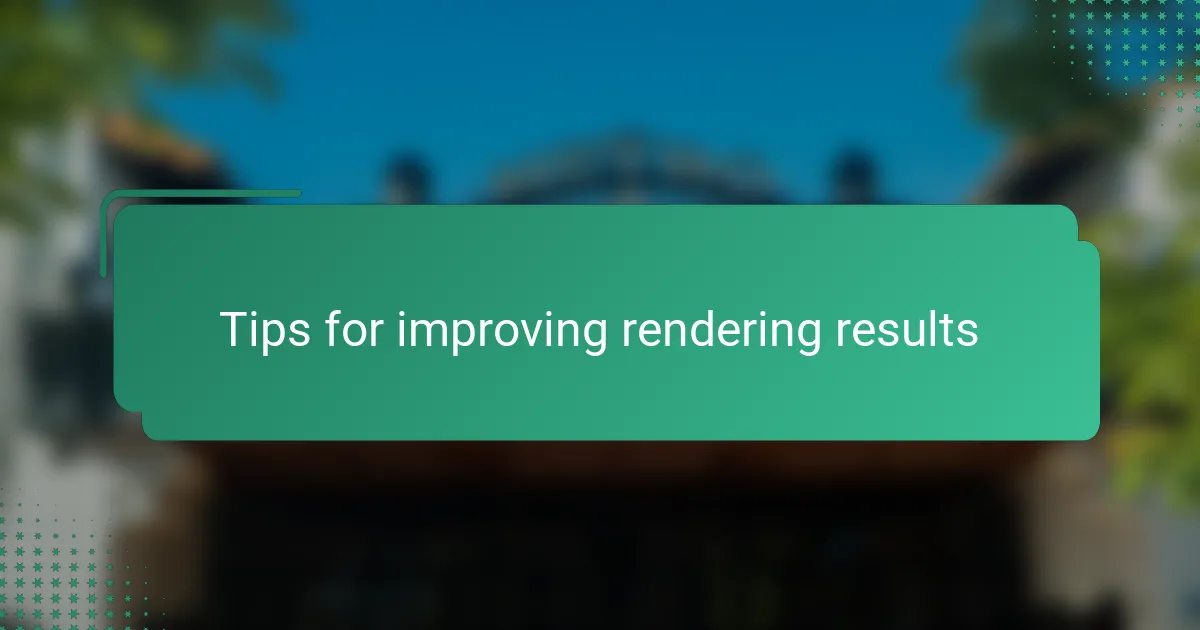
Tips for improving rendering results
One tip that really changed my rendering game is paying close attention to lighting setups. I used to underestimate how subtle shifts in light direction or intensity could dramatically improve the realism of a sci-fi prop. Have you ever tried adjusting a single light source only to see the whole scene come alive? That moment of discovery made me realize lighting isn’t just a technical detail—it’s storytelling in itself.
Another trick I found essential is optimizing textures without losing detail. Early on, I overloaded my scene with ultra-high-res maps, which caused frustrating lag. Learning to strike a balance—using clever mipmapping and efficient texture compression—helped keep the frame rate smooth while preserving the crispness I wanted. It took some trial and error, but the payoff in performance and visual quality was worth the effort.
Lastly, don’t underestimate the power of shader tweaking. I remember spending hours fine-tuning shader parameters on a metallic helmet to capture just the right amount of reflectivity and wear. Sometimes small tweaks made a massive difference in how believable the prop looked under different lighting conditions. Have you ever micromanaged a shader like that and felt a real connection to the piece? Those moments reminded me that rendering is as much art as it is science.
